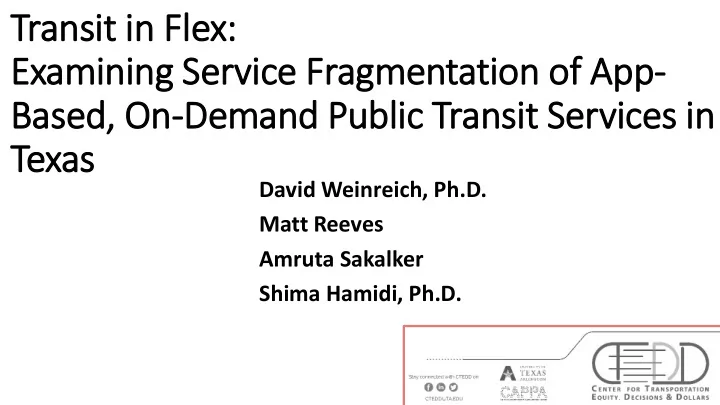

Transit in in Fle lex: Examining Service Fragmentation of App- Based, On-Demand Public Transit Services in in Texas David Weinreich, Ph.D. Matt Reeves Amruta Sakalker Shima Hamidi, Ph.D.
The Cost of f Transfers • Reduces ridership about 25% • Transfer between modes reduces ridership by 55% (Liu, Pendyala and Polzin 1998; 91-92) Photo by David Weinreich
Managing Transfers, Reducing Im Impacts • Smart cards • App-based fare payment • Shared transfer facilities • Coordinated scheduling/timed transfers • Shared Maintenance facilities • Shared information across agencies • Institutional Solutions (Rivasplata, 2012; Miller et al., 2005; Weinreich, 2016 & 2017)
Governance Impacts on Transit Coverage Dallas Area Rapid Transit (DART). DART History . https://www.dart.org/about/history.asp; Texas Association of Counties. Dallas County Profile. http://www.txcip.org/tac/census/profile.php?FIPS=48113
How can we tell if a metropolitan public transportation system is “regionalized”? To what degree are boundaries overcome? Public choice / regional reform debate: Feiock (2007; 2004); Norris (2001); Lowery (1999); Ostrom & Ostrom (1972); Ostrom, Tiebout & Warren (1961); Lowery Weinreich, Skuzinski et al., 2018 (1999) Networks literature: LeRoux & Carr (2010); Thermaier & Wood (2002) Policy integration literature: Miller (2004); Preston (2010); Stead & Meijers (2009) Service integration literature: Miller & Lam (2003), Miller et al. (2005) Transit collaboration literature: Bollens (1997); Crisholm (1989)
How can we tell if a metropolitan public transportation system is “regionalized”? Weinreich, Skuzinski et al., 2018 Are higher-scale organizations making decisions? Multilevel governance literature: Vogel (2007), Hamilton, Miller & Peytas (2004)
Typology of On-Demand Services in Literature Type Criteria Literature Examples From This Study Ridesourcing/Ride-Hailing/Transportation Network App-based service that (Rayle et al., 2016; Clewlow et -Capital Metro (MetroLink), Companies/TNCs connects community riders al., 2017; Jin et al., 2018) -DCTA (Highland Village Lyft who drive private cars for -Frisco AV customers -Frisco On-Demand (UNT Lyft) E-Hail Taxi service equipped for apps (Jin et al., 2018) Houston Arro Shared Ride-Hailing/Ridesplitting Combines passengers with a (Rayle et al., 2016; Clewlow et DART was interested in putting UberPool similar route, splits their fare al., 2017; Jin et al., 2018) in GoPass, but technology was not yet available to integrate it. Microtransit/Shared Minibus Private commuting services (Barbar & Burtch, 2017; Rayle -Alliance Link, similar to fixed route, with et al., 2016; Clewlow et al., -DART Rylie & Kleberg service rides reserved by app 2017; Jin et al., 2018) Demand Responsive Connectors Connects passengers with rail (Errico et al., 2013; Koffman et -Via, station al., 2004) -DART, -Capital Metro (both services), -San Antonio (planned) Zone routes Trips around town, within a (Errico et al., 2013; Koffman et -DART, specific zone al., 2004) -Denton (all six services), -Arlington Via, -Capital Metro Pickup Pilot, -San Antonio (planned)
Semi-Flexible Route Models (Erric ico et al, l, 2013; Koffman, , 2004)
Research Questions This project seeks to understand: 1) Employment of app-based, on-demand TNCs for public transit & purposes of these services. 2) Does government-planned, app-based, on- demand transit serve areas outside formal jurisdictional boundaries? 3) What app-based, on-demand providers have done to overcome jurisdictional fragmentation, and what they can do.
Descriptive Data 20 18 16 14 12 10 8 6 4 2 0 • Survey Population: 2,997, from Texas Municipal League list, Counties, MPOs, Transit Providers • Responses: 353 • 333 completed survey • Indicated on-demand service: 90 • Indicated app-based, on-demand service: 23 • Most cases were paratransit, rural, or suburban. Few urban.
Most= Supplement Traditional Transit, , Not a Replacement Supplement Replacement
Purpose of f App-Based, , On-Demand Services
Summary ry of f App- Based, On-Demand Services
Arlington On On-Demand w/ VIA Rideshare • Arlington On-Demand, operated by Via, offers a MOD zone for a flat fee of $3 (M-F 6am – 9pm, S 9am-9pm.) • Currently there are no monetary incentives to transfer between Arlington’s On -Demand service and existing transit. • Minimal advertising to reduce cost to city. • No signage at key transfer points. About VIA: http://www.arlington-tx.gov/residents/via/
Dallas Area Rapid Transit MOD zones are for first and last mile. Zones are currently not catering to all cities within DART service area.
Fin indings: 1) ) Physical In Infrastructure -Stations -Parking Bays -Sig ignage -Shelters alo long routes Photo by David Weinreich Photo by S. Matthew Reeves
2) ) Scheduling & Coordination -Requires: -Frequent fixed route service -Arrival time scheduled in advance. -Timed transfers -Service time coordinated with fixed route schedule. (Further research needed to quantify the effect on ridership and the rider experience).
3) ) Fare -Lack of transfer discount will discourage ridership (e.g. when covered by two agencies, or service by a private contractor like Uber or Via).
4) ) In Information Sharing TapRide Application, DART GoLink -Need better sharing between pilots. (Reeves, transit agencies, and with 2019) private contractors like Uber. -Makes difficult to coordinate services, and sync supply with demand.
5) ) Special Events -Found little evidence of integration in our cases. -One service avoided providing rides after 9pm, as many special events occur then — to reduce costs. Photo by David Weinreich
6) ) Apps -Multiple apps, sometimes overlapping in the same city or same agency. -Private apps exacerbate situation -Makes coordination difficult for the other five areas. -Hampers use of services as first/last mile feeders.
Moving Forward - Don’t assume app -based, on-demand services will be good feeders into fixed route transit. -Some permanence is good: e.g. sheltered waiting areas, signage. -Financial disincentives for high level of service in dense areas. -Funding at higher levels of government (E.g. MPO, State, Federal) -Leverage existing programs like Sandbox Grants to require coordination. -Coordination across agencies: MOUs, multi-jurisdictional funding, informal agreements.
Thank You https://www.autocar.co.nz/commercial-news-app/via-and-mercedes-benz-launch-london-rideshare-service david.weinreich@uta.edu
Survey Distribution and Response Characteristics Number Rate (%) Population 2,997 Starts 418 13.9 Responses 353 11.8 Non-consent 6 1.7 No item completion 14 4.0 Completions 333 94.3
Research framework Localized patterns of interaction increased measures of gaps in coverage and access Institutions Regional Transit Operations Decisions Regional patterns of interaction decreased measures of gaps in coverage and access
Recommend
More recommend